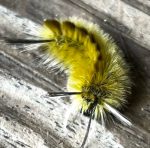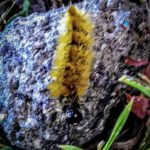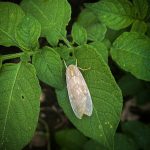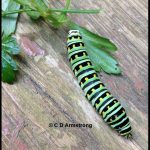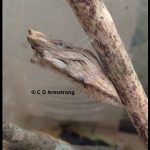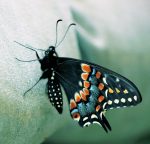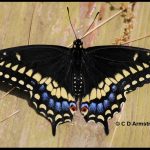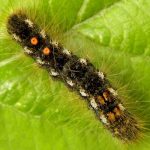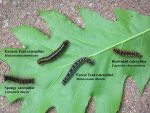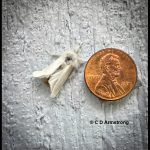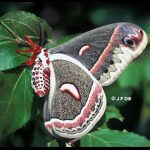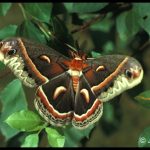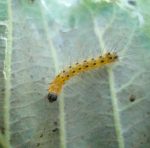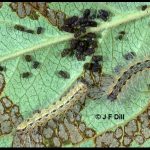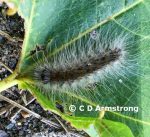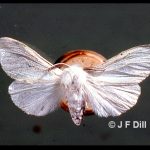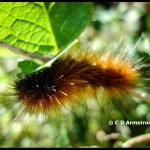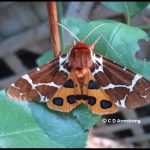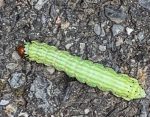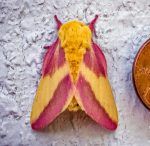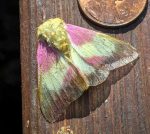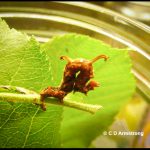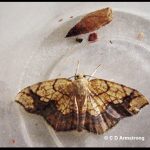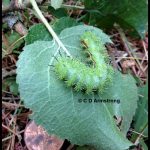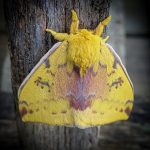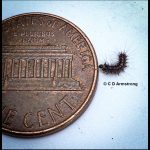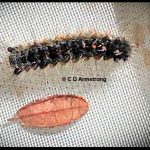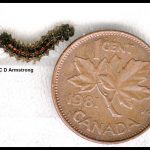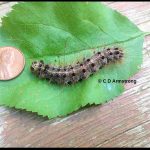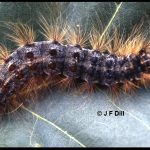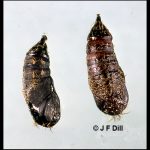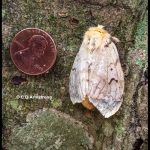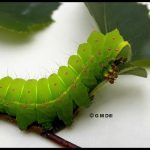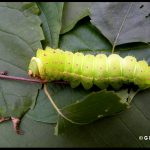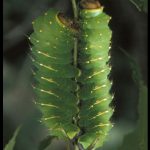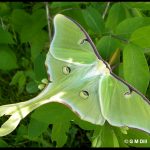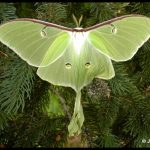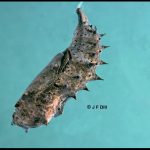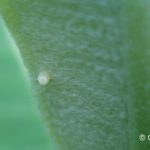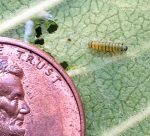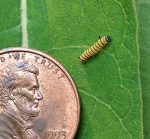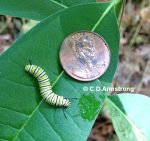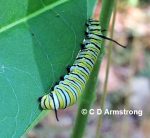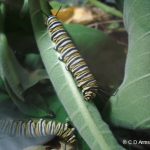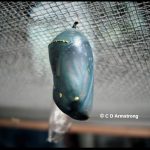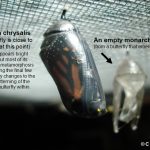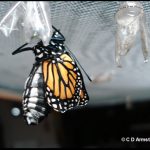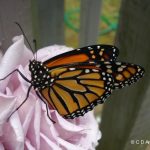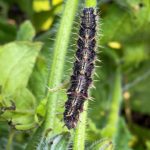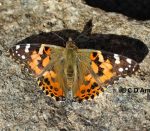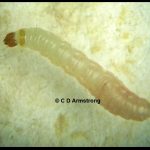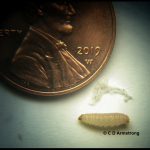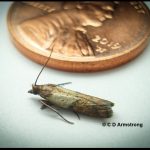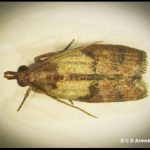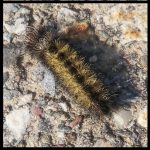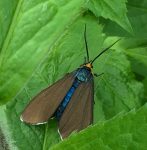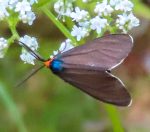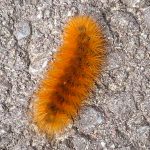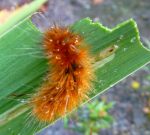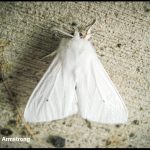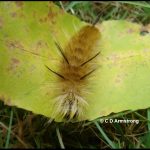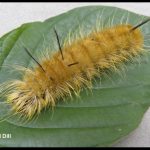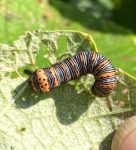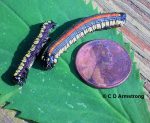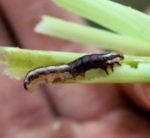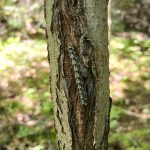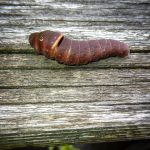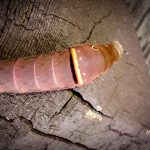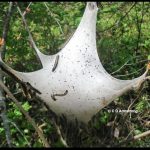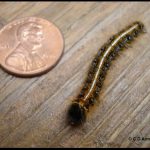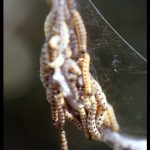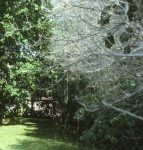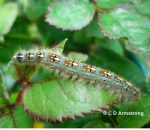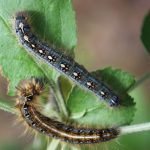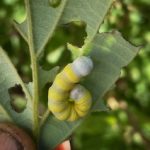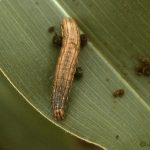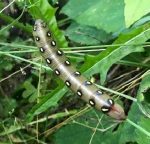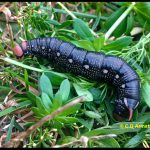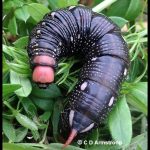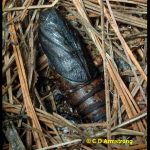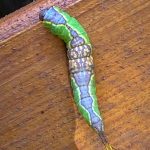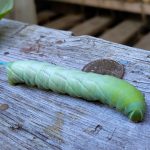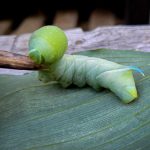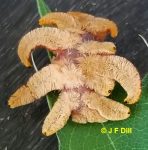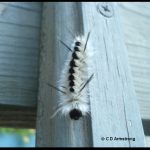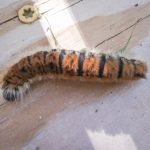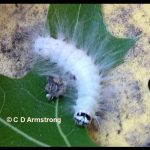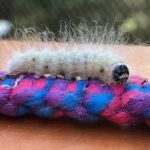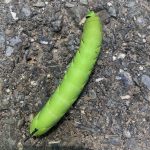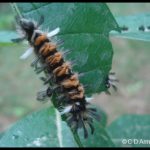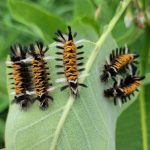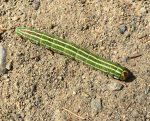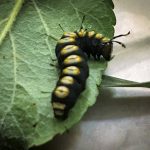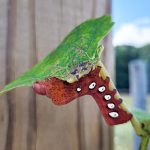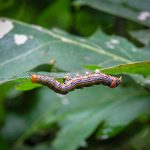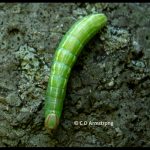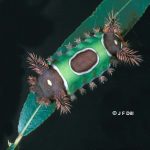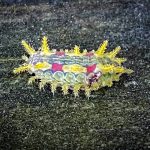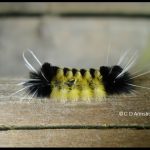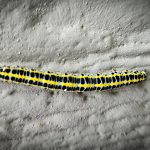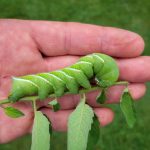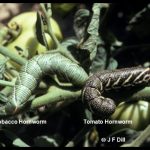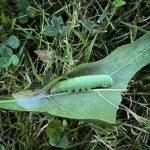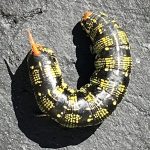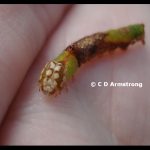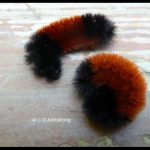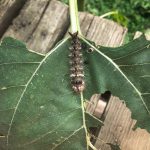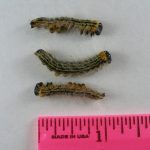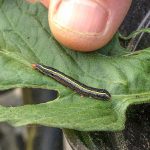Photo Gallery: Caterpillars and what they Become
Also worth a look: (May 2nd, 2024) Living with Caterpillars / “Caterpillar Season” by the Maine Forest Service
- Banded Tussock (Halysidota tessellaris) (Hollis, ME; 9/8/2023) (Photo courtesy of Elizabeth Saunders)
- Banded Tussock (most of the long hairs on this specimen have broken off; it’s a defensive adaptation) (9/3/2020; Farmington, ME; photo courtesy of Hannah A.)
- Banded Tussock Moth (Halysidota tessellaris) (Naples, ME; 6/18/2024) (Photo courtesy of M. Shepard)
- Full-grown caterpillar of the Black Swallowtail (other names: Eastern Black Swallowtail, American Swallowtail, Parsnip Swallowtail, Parsley Caterpillar, Celeryworm, and Caraway worm)
- Chrysalis of the Black Swallowtail, supported by two strands of silk called a silk girdle (‘brown’ form of chrysalis shown here; there is also a ‘green’ form which is green)
- Eastern Black Swallowtail butterfly (newly emerged from its chrysalis which can be seen in the bottom left of the image) (Etna, ME; 6/19/2019)
- Eastern Black Swallowtail Butterfly (male) — Papilio polyxenes (Etna, ME; 6/19/2019)
- Browntail Moth (late instar caterpillar stage)
- Comparison of four different caterpillar species in Maine that are sometimes difficult for people to differentiate, and oak is one of the hosts they all have in common (Photographed: central Maine; 6/12/2022) (Eastern Tent caterpillar, Spongy caterpillar, Forest Tent caterpillar, and the Browntail caterpillar)
- Browntail Caterpillars on a crabapple tree in Waterville, Maine; 5/12/2021 (Photo courtesy of Jamie Graves)
- Browntail Moth (Etna, ME; 6/28/2021)
- Cecropia Caterpillars
- Cecropia Caterpillars
- Cecropia Moth (Hyalophora cecropia)
- Cecropia Moth
- Fall Webworm caterpillar (early stage of development) (these build nests but they are not considered to harm most trees that are generally healthy)
- Pair of Fall Webworm caterpillars feeding on a crabapple leaf
- A mature Fall Webworm larva (Farmington, ME; 9/5/2020)
- Fall Webworm Moth (see also an example of the spotted form of the fall webworm moth)
- Garden Tiger Caterpillar (also called Great Tiger) (Monhegan Island, ME; 9/12/2011)
- Garden Tiger Caterpillar
- Garden Tiger Moth / Great Tiger Moth (Arctia caja)
- Green-striped Mapleworm Caterpillar (turns into the Rosy Maple Moth) (Dryocampa rubicunda) (Orono, ME; 7/26/2022) (Photo courtesy of Wendy Morrill)
- Rosy Maple Moth (Dryocampa rubicunda) (Etna, ME; 6/19/2021)
- Rosy Maple Moth (older specimen) (Dryocampa rubicunda) (Etna, ME; 5/27/2021)
- Horned Spanworm (a.k.a. Filament Bearer) (Washington County, Maine; 6/24/2004)
- Horned Spanworm Moth (a.k.a. Filament Bearer) (shown with the empty pupa from which it emerged) (Washington County, Maine; 9/29/2008)
- Io Caterpillar (Automeris io) – Plymouth, Maine (August 11, 2019) (possesses stinging spines)
- Io Moth (Automeris io) (St. George, ME; 6/25/2024) (Photo courtesy of B. Mroz)
- 2nd instar Spongy moth caterpillar (males go through five instar stages, while females go through six; each stage lasts about two weeks depending on weather)
- 3rd instar Lymantria dispar caterpillar (6/17/2019; Turner, Maine)
- 4th instar Lymantria dispar (Spongy Moth) caterpillar
- Lymantria dispar (final instar/mature larva)
- Lymantria dispar (final instar/mature larva) (Common Name: Spongy Moth)
- A pair of Spongy Moth (Lymantria dispar) pupae
- Spongy Moth (Lymantria dispar) (male)
- Spongy Moth (Lymantria dispar) (female) (Dixmont, ME; 7/12/2021)
- Full-grown caterpillar of the Luna Moth
- Full-grown caterpillar of the Luna Moth
- Pair of Luna Moth caterpillars
- Luna Moth
- Luna Moth
- Mourning Cloak Caterpillar (Nymphalis antiopa)
- Mourning Cloak chrysalis
- Mourning Cloak Butterfly (Nymphalis antiopa)
- Egg stage of a Monarch (on host plant, milkweed) (eggs hatch after roughly four days)
- Monarch caterpillar (1st-instar stage) (on host plant, milkweed) (August 9th, 2019; central Maine)
- Monarch caterpillar (2nd-instar stage) (on host plant, milkweed) (August 9th, 2019; central Maine)
- Monarch caterpillar (4th-instar stage) (on host plant, milkweed) (August 9th, 2019; Warren, Maine)
- A mature Monarch caterpillar (5th instar) – Warren, ME (8/9/2019) (on host plant, milkweed)
- Monarch caterpillars (5th and final instar stage) (on host plant, milkweed)
- A Monarch chrysalis a few days away from butterfly emergence (8/29/2006)
- A Monarch chrysalis in an advanced stage (final minutes before adult emergence)
- A Monarch butterfly newly-emerged (Their wings are small at first but within a matter of minutes they slowly expand to full size as fluid from the body is pumped into the wings)
- A young Monarch butterfly resting on a rose (central Maine)
- Monarch Butterfly feeding on a red clover blossom; 8/20/2018. Turner, Maine.
- Painted Lady caterpillar (Vanessa cardui) feeding on borage/starflower (Morrill, ME; 7/25/2023) (Photo courtesy of C. Chalmers)
- Painted Lady Butterfly (Vanessa cardui) (Schoodic Point in Winter Harbor, Maine; 10/10/2017)
- Painted Lady Butterfly (Vanessa cardui) (Camden, Maine; 8/14/2017)
- Pantry Moths / Flour Moths (Plodia interpunctella) (plus larvae and the webbing that the larvae spin)
- Magnified view of a mature Pantry Moth / Flour Moth larva
- A mature Pantry Moth / Flour Moth (Plodia interpunctella) larva with some of its silk webbing that they spin (you can see the webbing between the larva and the coin)
- Pantry Moth / Flour Moth (Plodia interpunctella)
- Pantry Moth / Flour Moth (Plodia interpunctella) (newly-emerged; 4/23/2021)
- Virginia Ctenucha (Ctenucha virginica) (Orono, ME; 3/10/2022) (Photo credit: courtesy of Edward S. Grew)
- Virginia Ctenucha (Ctenucha virginica) (Pittston, ME; 6/24/2022)
- Virginia Ctenucha (Ctenucha virginica) on Valerian flowers (Orono, ME; 7/7/2022) (Photo credit: courtesy of Edward S. Grew)
- Yellow Bear Caterpillar / Yellow Woollybear (Spilosoma virginica) (Orono, ME; 8/25/2022) (Photo courtesy of Edward S. Grew)
- Yellow Bear Caterpillar / Yellow Woollybear (Spilosoma virginica) (turns into the Virginian Tiger Moth) (Greenville, ME; 9/4/2011)
- Virginian Tiger Moth (Spilosoma virginica) (Etna, ME; 6/30/2009) (If the abdomen is hidden, this moth is sometimes mistaken for the Browntail Moth, Euproctis chrysorrhoea)
Caterpillars
Our page also includes caterpillars for which we do not as yet have corresponding moth or butterfly photos | See also: Caterpillars of Eastern Forests [pdf] (USDA Forest Service).
- Banded Tussock (BugGuide.net)
- Black Swallowtail / Eastern Black Swallowtail (University of Florida)
- Browntail Moth/Caterpillar
- Cecropia Moth
- Cutworms
- Eastern Tent Caterpillars
- Euonymus Caterpillars
- Fall Webworm
- Forest Tent Caterpillars
- Garden Tiger Moth (Butterflies and Moths of North America Project)
- Green-striped Mapleworm / Rosy Maple Moth (BugGuide.net)
- G**** Moth — find it now by its new name of Spongy Moth
- Hickory Tussock Caterpillar
- Hornworms
- Indian Meal Moth / Pantry Moth
- Io Moth (Butterflies and Moths of North America Project)
- Laugher caterpillar
- Loopers (USGS)
- Luna Moth
- Milkweed Tussock (BugGuide.net)
- Monarch Butterfly and Caterpillar
- Moths (The Butterflies and Moths of North America project)
- Mourning Cloak (The Butterflies and Moths of North America project)
- Painted Lady Butterfly
- Pantry Moth
- Polyphemus Moth (Butterflies and Moths of North America Project)
- Redhumped Caterpillars (Washington State University)
- Rosy Maple Moth (BugGuide.net)
- Slug Caterpillars (BugGuide.net)
- Spruce Budworm
- ‘The Laugher’ caterpillar
- Tobacco Hornworm
- Tomato Hornworm
- Tussock Caterpillars
- Virginia Ctenucha (Butterflies and Moths of North America project)
- Virginian Tiger Moth (BugGuide.net)
- Winter Moth (Maine Forest Service)
- Woollybear Moths (BugGuide.net): Banded Woollybear (Isabella Tiger Moth) and Yellow Woollybear (Virginian Tiger Moth)
- Yellownecked Caterpillars (Penn State University)
For a listing of butterflies in Maine (with photos), visit the Maine Butterfly Survey site. And, for a comprehensive listing of backyard tree caterpillars (with photos), check out the USDA Forest Service’s Caterpillars of Eastern Forests [pdf].
Various Other Caterpillars (with links to other sites for adult-stage images):
See also: Caterpillars of Eastern Forests (PDF) (US Forest Service) and some examples of sawfly larvae which highly resemble caterpillars (scroll to bottom of page).
- American Dagger Caterpillar (Acronicta americana) (very large host range) (Stetson, ME; 10/8/2010)
- American Dagger Caterpillar (Acronicta americana)
- American Lappet (Phyllodesma americana) (Buxton, ME; 9/1/2023) (Photo courtesy of Vanessa Cariddi)
- Beautiful Wood-nymph (Eudryas grata) (feeding on grape leaves–one of its host plants–in Naples, ME; 8/24/2023) (Photo courtesy of M. Shepard)
- Pair of Brown-hooded Owlet Caterpillars (Cucullia convexipennis). They feed principally on asters and goldenrods, but presumably on other Asteraceae plants as well.
- Common Stalk Borer
- Dimorphic Pinion (Lithophane patefacta) resting on the trunk of a white ash tree (Northeast Harbor, ME; 7/11/2024) (Photo courtesy of Noah Sawyer)
- Eastern Tiger Swallowtail (Papilio glaucus) (on a deck railing; Farmington, ME; 9/11/2024) (Photo courtesy of Mort Stabulis)
- Eastern Tiger Swallowtail (Papilio glaucus) (Farmington, ME; 9/11/2024) (Photo courtesy of Mort Stabulis)
- A nest of Eastern Tent Caterpillars (Mid-May, 2012; Aurora, ME)
- A mature Eastern Tent Caterpillar (Central Maine: June 5th, 2015)
- A heavy infestation of Euonymus caterpillars
- A fully-grown Forest Tent Caterpillar (Malacosoma disstria) on a rosebush (Etna, ME; 6/4/2015)
- Comparing the Eastern Tent Caterpillar (bottom) with a Forest Tent Caterpillar (above). Both were feeding on the leaves of a wild apple tree. The Eastern tent caterpillars make silken nests in the forks of their host trees whereas the forest tent caterpillars make no nests at all, in spite of having “tent” in their name (Etna, ME; 6/5/2015)
- Eyed Mustard Sallow / Citrine Sallow (Pyreferra citrombra) (feeding on Fothergilla) (6/13/2024; North Lovell, ME) (Photo courtesy of Kristen McDermott)
- Fall Armyworm Caterpillar (on a corn leaf)
- Galium Sphinx / Bedstraw Sphinx (Hyles gallii) (Fayette, ME; 7/6/2022) (Photo courtesy of Ellen Lamb)
- Galium Sphinx / Bedstraw Sphinx (Hyles gallii) (placed in this random area on the ground only for photo purposes) (Oct. 22nd, 2019)
- Galium Sphinx (also called Bedstraw Sphinx as bedstraw is one of its ‘preferred’ hosts, along with fireweed and other plants in the evening primrose family) (Oct. 22nd, 2019)
- Galium Sphinx pupa (the same caterpillar shown in the two adjacent left images, after it had pupated) (11/6/2019)
- Gray Furcula (Furcula cinerea) (Sebago, ME; 7/27/2022) (Photo courtesy of Kim Colson)
- Great Ash Sphinx (St. George, ME; 9/2/2024) (Photo courtesy of B. Mroz)
- Great Ash Sphinx (Sphinx chersis) (St. George, ME; 9/2/2024) (Photo courtesy of B. Mroz)
- Hag Moth Caterpillar (Phobetron pithecium) on an oak leaf (Palmyra, ME; 8/17/2020) (Caution: caterpillar has stinging spines)
- Hickory Tussock (the hairs on many tussock caterpillars can cause an itchy rash)
- Large Gray Dagger (Acronicta insita) (named for how gray the moth is) (Sanford, Maine; host tree was Corkscrew Willow; 9/27/2021) (larvae feed on alder, birch, poplar, hawthorn and willow) (Photo courtesy of Janet Nittolo)
- “The Laugher” Caterpillar (Bangor, Maine; 9/22/2017) (easy to confuse with the Hickory Tussock caterpillar)
- “The Laugher” Caterpillar – Charadra deredens (Photo courtesy of Becky B.) (Georgetown, ME 9/12/2020)
- Laurel Sphinx (Sphinx kalmiae) (Orono, ME; 8/3/2022) (Photo courtesy of Wendy Morrill)
- Milkweed Tussock Caterpillar (Euchaetes egle) (Etna, ME; 8/23/2009) (this caterpillar is not an invasive species)
- Milkweed Tussock Caterpillars (Euchaetes egle) (Falmouth, ME; 7/25/2024) (these caterpillars are not an invasive species) (Photo courtesy of Jenni Cappello)
- Northern Pine Sphinx (Lapara bombycoides) (Photo courtesy of J&S Grant) (Plymouth, ME – late August, 2020)
- Owl-eyed Bird Dropping caterpillar (Cerma cora) (Oakland, ME; 7/10/2024) (Photo courtesy of Leanne Clark)
- Owl-eyed Bird Dropping caterpillar (Cerma cora) (Oakland, ME; 7/10/2024) (Photo courtesy of Leanne Clark)
- Paddle Caterpillar (rare), Acronicta funeralis (or Funerary Dagger Moth caterpillar) (Hartland, ME; July 26, 2020) (Photo courtesy of Lachlan Ainsworth)
- Pandora Sphinx (Eumorpha pandorus) feeding on grape (Brunswick, Maine; 8/29/2022) (Photo courtesy of the Brunswick Topsham Land Trust)
- Red-humped Oakworm (Symmerista canicosta) (Sangerville, ME; 8/20/2024) (Photo courtesy of Bob)
- Saddled Prominent (Heterocampa guttivitta); Acadia National Park (South Bubble trail); August 5th, 2020.
- Saddleback Caterpillar (turns into a moth) (possesses stinging spines)
- Spiny Oak-slug (Euclea delphinii) (possesses stinging spines) (Oakland, ME; 9/9/2022) (Photo courtesy of Leanne Clark)
- Spotted Tussock
- Toadflax Brocade (Calophasia lunula) (Exeter, ME; 6/17/2024) (Photo courtesy of S.E. Crawford)
- Tobacco Hornworm / Carolina Sphinx (Manduca sexta) (St. George, ME; 8/12/2024) (Photo courtesy of B. Mroz)
- Tobacco Hormworm (left) and a Tomato Hornworm (right); many people in Maine and beyond encounter tobacco hornworms feasting on their tomato plants so incorrectly assume they are tomato hornworms.
- Collection of Hornworm Photos, including the Laurel Sphinx (USGS)
- White-dotted Prominent (Nadata gibbosa) (on red oak) (Camden, ME; 8/8/2024) (Photo courtesy of Daniel Thrall)
- White-lined Sphinx (Hyles lineata) (Auburn, ME; 9/17/2022) (Photo courtesy of Linda DeSantis)
- White-streaked Prominent (Oligocentria lignicolor); Boothbay, ME (8/26/2010)
- White-streaked Prominent (Oligocentria lignicolor); Boothbay, ME (8/26/2010)
- Woollybear Caterpillars (Banded Woollybear)
- Yellow-haired Dagger (Acronicta impleta) on a sunflower leaf (Orrington, ME; 8/13/2024) (Photo courtesy of “Grammar Girl”)
- Yellownecked Caterpillars (photo courtesy of J. St. Clair; August 14, 2013)
- Yellowstriped Armyworm caterpillar (Spodoptera ornithogalli) (Belgrade, ME; July 28th, 2021) (photo courtesy of Leilani Carlson)
Links to Images of Adult Stage:
- American Dagger Moth (Butterflies and Moths of North America Project)
- American Lappet Moth (BugGuide.net)
- Beautiful Wood-nymph (BugGuide.net) (caterpillar is very similar to the Eight-spotted Forester except for the absence of hairs on its body)
- Brown-hooded Owlet Moth (Butterflies and Moths of North America Project)
- Common Stalk Borer (Iowa State University)
- Dimorphic Pinion Moth (Butterflies and Moths of North America Project) | Dimorphic Pinion (BugGuide.net)
- Eastern Tiger Swallowtail (BugGuide.net)
- Eastern Tent Caterpillar (moth stage) (BugGuide.net)
- Euonymus Moth (BugGuide.net)
- Eyed Mustard Sallow / Citrine Sallow (BugGuide.net)
- Fall Armyworm Moth (BugGuide.net)
- Forest Tent Caterpillar (moth stage) (BugGuide.net)
- Galium Sphinx Moth (BugGuide.net)
- Great Ash Sphinx Moth (BugGuide.net)
- Grey Furcula Moth (BugGuide.net)
- Hag Moth / Monkey Slug (BugGuide.net)
- Hickory Tussock (Hickory Tiger) (moth stage) (Butterflies and Moths of North America Project)
- Horned Spanworm (Butterflies and Moths of North America Project)
- Large Gray Dagger (BugGuide.net)
- Laugher (Moth) (BugGuide.net)
- Laurel Sphinx Moth (Butterflies and Moths of North America Project)
- Milkweed Tussock Moth (also known as a Milkweed Tiger Moth) (BugGuide.net)
- Northern Pine Sphinx Moth (BugGuide.net)
- Owl-eyed Bird Dropping Moth (BugGuide.net)
- Paddle Moth / Funerary Dagger Moth (rare) (BugGuide.net)
- Pandora Sphinx Moth (BugGuide.net)
- Red-humped Oakworm (BugGuide.net)
- Saddled Prominent Moth (North American Moth Photographers Group)
- Slug Caterpillars (BugGuide.net)
- Saddleback Moth (Butterflies and Moths of North America project)
- Spiny Oak-slug Moth (BugGuide.net)
- Spotted Tussock Moth (Butterflies and Moths of North America Project)
- ‘The Laugher’ (Moth) (BugGuide.net)
- Toadflax Brocade Moth (BugGuide.net)
- Tobacco Hornworm Moth (also called Carolina Sphinx) (Butterflies and Moths of North America Project)
- White-dotted Prominent (BugGuide.net)
- White-lined Sphinx Moth (BugGuide.net)
- White-streaked Prominent (BugGuide.net)
- Woollybear Moths (BugGuide.net): Banded Woollybear (Isabella Tiger Moth) and Yellow Woollybear (Virginian Tiger Moth)
- Yellow-haired Dagger Moth (BugGuide.net)
- Yellownecked Moth (Butterflies and Moths of North America project)
- Yellowstriped Armyworm Moth (BugGuide.net)

